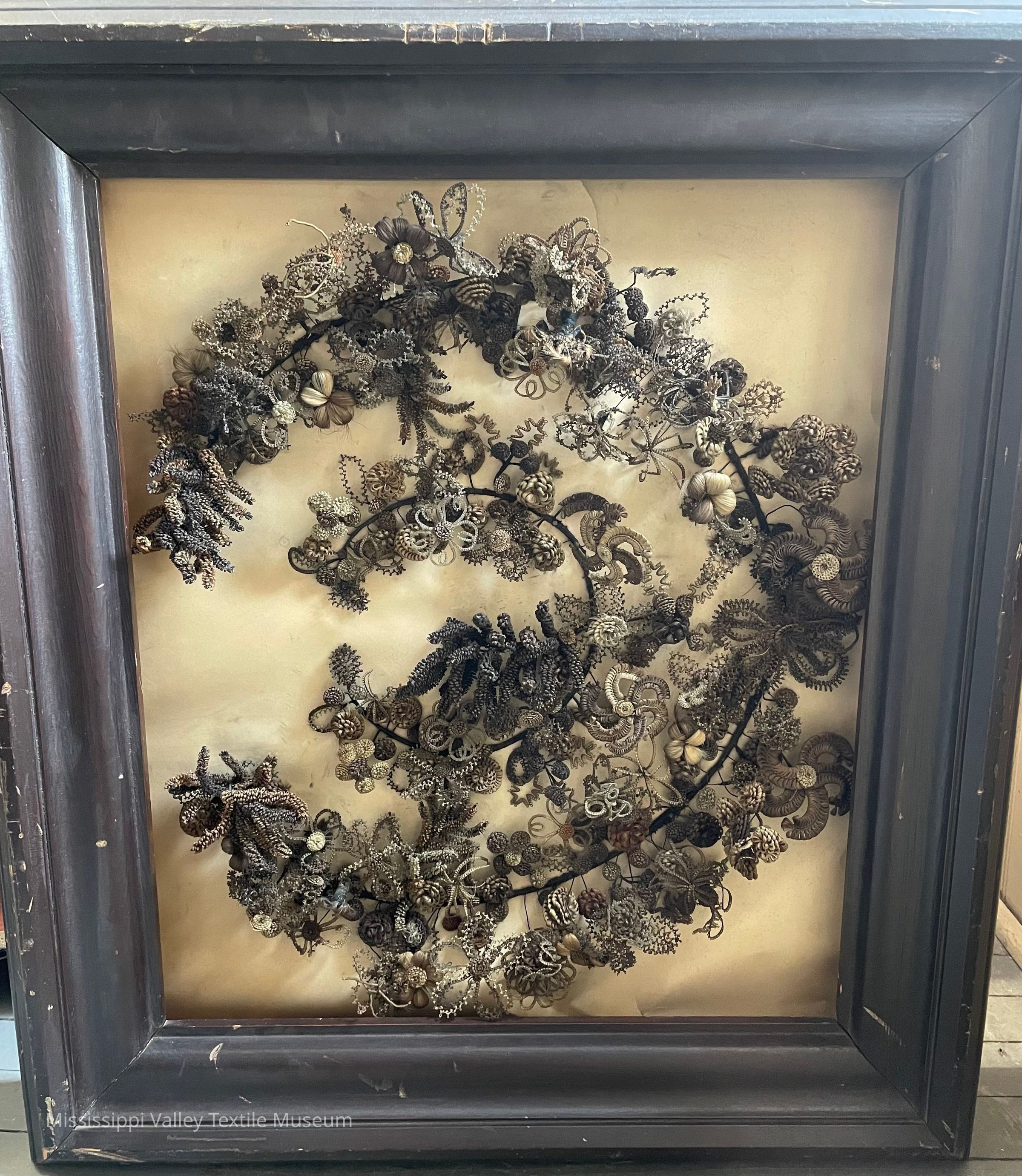Research Type
ResearcherPerson
Anna ReepschlagerDate
Apr 10, 2025Notes
Research Notes:
Victorian hair wreaths are an example of hair work, a style of Victorian home craft which was practiced during the late-1700s and 1800s [1], and was used to create display pieces and wearable pieces such as jewellery using human hair, including: “parlour domes, shadow boxes, family trees, and jewellery including earrings, bracelets, rings, brooches, and necklaces.” [2]
The craft of hair work — and the creation and display of Victorian hair wreaths — can be situated within the larger context of wearing and creating jewellery made with or containing locks of loved ones’ hair. Hair work was created both professionally and as a home craft. Vendors sold pre-made pieces and commissioned pieces with loved ones hair — alongside resources for home craft, including pattern books and resource books, and hair samples (especially those with varying colours of hair) [1] . However, homemade pieces were often preferred since some vendors were known to con their customers by sending pre-made pieces, rather than commissioned pieces [1]. A concern for using home craft to ensure the authenticity of the hair was alluded in a text published in 1867, writing that: “Persons wishing to preserve and weave into lasting mementos … can also enjoy the inexpressible advantage and satisfaction of knowing that the material of their own handiwork is the actual hair of the “loved and gone” [3]. As a material, hair was ”an intensely personal memento and its enduring qualities, hair work was seen as the embodiment of bond between individuals.” [1]
Multiple sources identify a peak in the popularity of creating hair wreaths around the mid- to late-1800s, waning towards the end of the century [1] [4]. Hair wreaths themselves were often used to memorialize deceased family members, “because of its connotations as a token of deep affection and a relic that allowed a piece of the missing individual to stay present” [1]. Due to their size and intricacy, it was often impossible to make them with the hair of only one family member, so they often represented composites of multiple individuals hair [1]. This could include using hair from family members, trading hair with friends [4], purchasing hair — or even using horse hair [2]. In addition to memorializing deceased family members, wreaths were thought to also be a way of recording family history [1] or “symbolize friendships” [4]. The Maine State museum suggests that “exchanging locks of hair was like friends sharing yearbook photos today.” Similarly, hair accessories were a “symbol of sentimentality … used to celebrate love, friendship, family, and death” [2]. Hair wreaths were typically decorative, and displayed in the home [2].
A hair wreath in the Smithsonian’s collection (See Ref. 1) identifies the techniques used as crochet and tatting — however, further investigation could be done on the piece in the MVTM collection to investigate techniques used.
Potential Resources for Future Research:
Self-instructor in the art of hair work, dressing hair, making curls, switches, braids, and hair jewelry of every description
Campbell, Mark
1867
Link: https://archive.org/details/selfinstructori00campgoog/page/n12/mode/2up
This text doesn't get in depth about hair wreaths themselves, but provides an introduction written during the height of popularity of hair work (mid- to late-1800s), with notes on the craft of hair work, and gives details on preparing hair for hair work and instructions for some styles of hair work including hairstyles and making jewellery
Includes the following note on handcrafting items made with the hair of recently deceased relatives: “Persons wishing to preserve and weave into lasting mementos, the hair of a deceased father, mother, sister, brother, or child, can also enjoy the inexpressible advantage and satisfaction of knowing that the material of their own handiwork is the actual hair of the “loved and gone” [Preface]
Although the piece in the collection doesn’t have any specific provenance, I located a second example of a hair wreath with more provenance information at the Craigdarroch Museum, which is noted as coming from Ontario, and could potentially give some context to other hair wreaths in the province.
The museum notes:
“One magnificent example in Craigdarroch Castle’s collection is the large hair wreath that can be seen in Joan Dunsmuir’s Sitting room … The piece … was made by Sarah Hunter in Ontario between 1866 and 1870. The wreath features a decorative heart-shaped arrangement and it was created using Sarah’s hair, her parents’ hair, the hair of her six sisters, as well as hair from the family horse … Due to the nature of parlour art and since they were produced by women, the name of many artists are unknown. In this case, we are very lucky to know the maker, some of her history, and even have a picture of Sarah Hunter.”
Sources:
[1] Smithsonian. Hair Art, Lyre. Smithsonian Gardens. https://www.si.edu/object/hair-art-lyre%3Ahac_1986.021 Accessed: April 10, 2025.
[2] Pineault-B, Elaine. 2020. Victorian Women and Parlour Art — Hair Work. Craigdarroch Castle. https://thecastle.ca/news/victorian-women-and-parlour-art-hair-work/ Accessed: April 10, 2025.
[3] Campbell, Mark. 1867. Self-instructor in the art of hair work, dressing hair, making curls, switches, braids, and hair jewelry of every description. https://archive.org/details/selfinstructori00campgoog/page/n14/mode/2up Accessed: April 10, 2025.
[4] Hair Wreaths — Sentimental or Spooky? Maine State Museum. https://mainestatemuseum.org/hair-wreaths/ Accessed: April 10, 2025.
